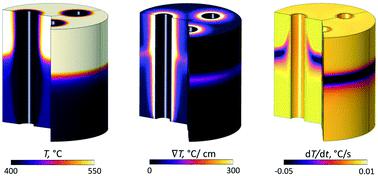当前位置:
X-MOL 学术
›
React. Chem. Eng.
›
论文详情
Our official English website, www.x-mol.net, welcomes your feedback! (Note: you will need to create a separate account there.)
Predicting thermal excursions during in situ oxidative regeneration of packed bed catalytic fast pyrolysis catalyst
Reaction Chemistry & Engineering ( IF 3.9 ) Pub Date : 2021-3-26 , DOI: 10.1039/d1re00007a Bruce D. Adkins 1, 2, 3 , Zach Mills 1, 2, 3 , James Parks II 1, 2, 3 , M. Brennan Pecha 3, 4, 5 , Peter N. Ciesielski 3, 4, 5 , Kristiina Iisa 3, 4, 5 , Calvin Mukarakate 3, 4, 5 , David J. Robichaud 3, 4, 5 , Kristin Smith 3, 4, 5 , Katherine Gaston 3, 4, 5 , Michael B. Griffin 3, 4, 5 , Joshua A. Schaidle 3, 4, 5
Reaction Chemistry & Engineering ( IF 3.9 ) Pub Date : 2021-3-26 , DOI: 10.1039/d1re00007a Bruce D. Adkins 1, 2, 3 , Zach Mills 1, 2, 3 , James Parks II 1, 2, 3 , M. Brennan Pecha 3, 4, 5 , Peter N. Ciesielski 3, 4, 5 , Kristiina Iisa 3, 4, 5 , Calvin Mukarakate 3, 4, 5 , David J. Robichaud 3, 4, 5 , Kristin Smith 3, 4, 5 , Katherine Gaston 3, 4, 5 , Michael B. Griffin 3, 4, 5 , Joshua A. Schaidle 3, 4, 5
Affiliation

|
Ex situ catalytic fast pyrolysis (CFP) uses a secondary reactor to upgrade biomass pyrolysis vapors to stabilized CFP oils with reduced oxygen content. In one configuration, the secondary reactor is operated as a packed-bed swing reactor system which allows coke-deactivated beds to be decarbonized in situ while other beds remain online for vapor upgrading. In situ decarbonization must be done carefully to avoid irreversible deactivation and/or physical degradation of catalyst pellets. Given that packed bed reactors are well known to have poor heat transfer characteristics, this is a critical issue impacting scaleability and commercial viability of the technology. To predict thermal excursions during regeneration, finite element computational models have been built to assist in scaling up oxidative decarbonization of a Pt/TiO2 CFP catalyst (0.5 mm spheres) from a bench scale packed bed with 100 g of catalyst to a pilot scale packed bed with 2 kg of catalyst and internal cooling tubes. Based on transient measurements of outlet temperature and effluent CO2 concentration, and using an assumed coke profile and activation energy, this paper demonstrates that specific combinations of effective thermal conductivity and wall heat transfer coefficient can fit bench scale oxidative regeneration data equally well. For the upscaled 2 kg bed, four bench-scale “best fit” parameter pairs give different predictions for location and magnitude of thermal excursions, with the maximum computed bed temperature gradients ranging from 30 °C cm−1 to as high as 3000 °C cm−1. The larger the fraction of heat removal by conduction through the cooling tubes, the greater the differences between the parameter pairs. The modelling results presented in this paper cast doubt on the industrial viability of the proposed combination of catalyst, bed and regeneration process, and point to the need for alternate reactor designs. However, there is considerable uncertainly in some of the key model parameters. The reliability of model predictions can be increased by adding more temperature measurements at key bed locations, testing additional variations in process conditions, performing careful bed dissections to determine the true coke profile, and perhaps most importantly, directly measuring the effective thermal conductivity of the catalyst pellets.
中文翻译:

预测填充床催化快速热解催化剂的原位氧化再生过程中的热偏移
易位催化快速热解(CFP)使用二级反应器将生物质热解蒸气升级为氧含量降低的稳定CFP油。在一种配置中,第二反应器作为填充床回转反应器系统运行,该系统允许将焦炭失活的床原位脱碳,而其他床保持在线以进行蒸汽提质。原位脱碳必须小心进行,以避免不可逆的失活和/或催化剂颗粒的物理降解。已知填充床反应器传热特性差,这是影响该技术的规模化和商业可行性的关键问题。为了预测再生过程中的热偏移,已建立了有限元计算模型,以帮助将Pt / TiO 2 CFP催化剂(0.5毫米球)的氧化脱碳放大,从装有100 g催化剂的台式填料床扩展到中试填料装有2千克催化剂的床和内部冷却管。基于出口温度和废水CO 2的瞬态测量浓度,并使用假定的焦炭分布和活化能,本文证明有效导热率和壁传热系数的特定组合可以很好地拟合实验规模的氧化再生数据。对于高档的2 kg床,四个工作台规模的“最佳拟合”参数对对热偏移的位置和幅度给出了不同的预测,最大计算床温梯度范围为30°C cm -1到高达3000°C厘米-1。通过冷却管传导的热量去除率越大,参数对之间的差异就越大。本文中提出的建模结果使人们对所提出的催化剂,床层和再生工艺相结合的工业可行性产生怀疑,并指出了对替代反应器设计的需求。但是,某些关键模型参数存在很大的不确定性。可以通过以下方法提高模型预测的可靠性:在关键床层位置添加更多的温度测量值,测试工艺条件中的其他变化,进行仔细的床层解剖以确定真实的焦炭分布,也许最重要的是,直接测量催化剂的有效热导率颗粒。
更新日期:2021-03-29
中文翻译:

预测填充床催化快速热解催化剂的原位氧化再生过程中的热偏移
易位催化快速热解(CFP)使用二级反应器将生物质热解蒸气升级为氧含量降低的稳定CFP油。在一种配置中,第二反应器作为填充床回转反应器系统运行,该系统允许将焦炭失活的床原位脱碳,而其他床保持在线以进行蒸汽提质。原位脱碳必须小心进行,以避免不可逆的失活和/或催化剂颗粒的物理降解。已知填充床反应器传热特性差,这是影响该技术的规模化和商业可行性的关键问题。为了预测再生过程中的热偏移,已建立了有限元计算模型,以帮助将Pt / TiO 2 CFP催化剂(0.5毫米球)的氧化脱碳放大,从装有100 g催化剂的台式填料床扩展到中试填料装有2千克催化剂的床和内部冷却管。基于出口温度和废水CO 2的瞬态测量浓度,并使用假定的焦炭分布和活化能,本文证明有效导热率和壁传热系数的特定组合可以很好地拟合实验规模的氧化再生数据。对于高档的2 kg床,四个工作台规模的“最佳拟合”参数对对热偏移的位置和幅度给出了不同的预测,最大计算床温梯度范围为30°C cm -1到高达3000°C厘米-1。通过冷却管传导的热量去除率越大,参数对之间的差异就越大。本文中提出的建模结果使人们对所提出的催化剂,床层和再生工艺相结合的工业可行性产生怀疑,并指出了对替代反应器设计的需求。但是,某些关键模型参数存在很大的不确定性。可以通过以下方法提高模型预测的可靠性:在关键床层位置添加更多的温度测量值,测试工艺条件中的其他变化,进行仔细的床层解剖以确定真实的焦炭分布,也许最重要的是,直接测量催化剂的有效热导率颗粒。



























 京公网安备 11010802027423号
京公网安备 11010802027423号